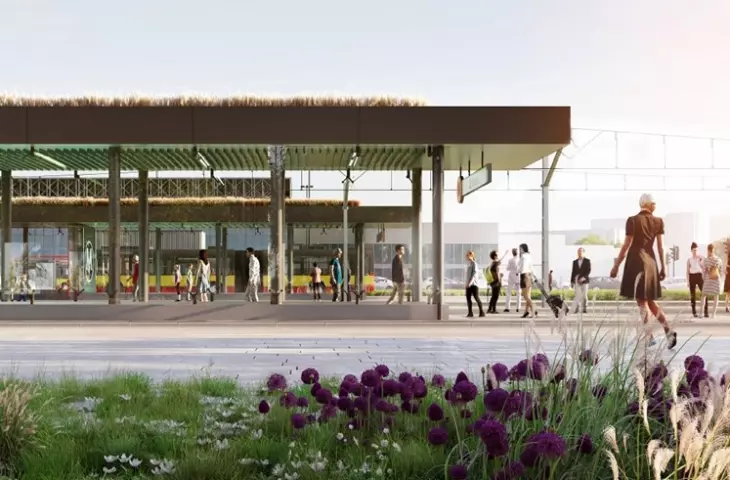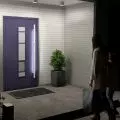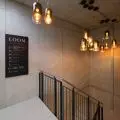Warsaw announces a tender for the design of the first section of the third subway line. The most happy about this may be the capital's... air. After all, according to City Hall forecasts, it is the air that will mainly fill the trains of the new line. Warsaw is embarking on the least-needed of the planned lines included in the master plan for the development of the underground rail network until 2050.
Design work will cover only the first section of the planned M3 line - from the National Stadium to Goclaw station. The new route - more than 8 kilometers long - will include seven stations, including six new ones. Construction of the M3 line should begin in 2028. The first passengers will ride it a few years later. The project will also include the construction of a Technical and Station at Kozia Górka, and many streets and important transportation hubs will be rebuilt, including the East Station and Wiatraczna Roundabout.
The subway station at Dwernickiego and KS Orzeł
© UM Warszawa / ILS
Six new stations will be designed. The line will begin its run at the existing National Stadium station (from the beginning, this station was designed as an interchange, but in the implementation it was truncated by several exits to the surface), Eastern Station, Minska, Rondo Wiatraczna, Ostrobramska, Jana Nowaka-Jezioranski, Goclaw. The project contractor will have 36 months to implement the tender assumptions from the moment the contract is signed.
Metro station at KS Orzeł
© UM Warszawa / ILS
windraczna, however, with bicycles
In October, the City boasted pre-design documentation for the M3, including concepts for the planned stations and the space above them. The changes, or rather the lack of them, relative to the current road layout may have come as a shock - the billion-dollar investment was to be stripped of key components of bicycle infrastructure, and pathological holes in the grid were to be preserved for years.
Wiatraczna Roundabout - previous concept
© UM Warszawa / ILS
Most disappointing was the shape of the Wiatraczna Roundabout proposed by the ILF designers. The district's most important transportation hub, the local center, was to be entirely stripped of bicycle infrastructure, and the existing, inconvenient layout of streetcar stops was to be preserved. The designed layout of exits from the new subway station did not take into account all key traffic routes, and streetcar stops were left on a central island cut off from the neighborhood by a minimum of three lanes.
Wiatraczna Roundabout - current concept
© UM Warszawa
In the drawings presented today, this pathological situation has completely changed. After the construction of the subway station, the place will no longer function as a traffic circle. The road layout will be simplified, thus improving safety. Public transport stops concentrated in the central part of the interchange will allow easy and fast transfers. Passengers' convenience will also be significantly affected by the shallower location of the subway station (over the planned tunnel of the downtown ring road), which will significantly reduce the time needed to reach the platforms. A multifunctional city square will be created in place of the relocated streetcar terminus, which will be an attractive space serving all residents. The station area will feature lots of greenery, a network of bicycle paths, elements of small architecture and a canopy over the key part of the interchange.
Wiatraczna Roundabout - current concept
© UM Warszawa / X portal entry - Jaroslaw Ossowski
The arrangement of the space - freed by traffic changes, with a new form of functioning commerce and greenery elements - will be the subject of design and consultation workshops with the participation of residents, merchants and all those interested in this important place for Praga. How it was possible that the previous project received agreements at all and was picked up by the City remains a mystery.
Wiatraczna Roundabout - previous concept
© UM Warszawa / ILS
The square in front of the East Railway Station
The design of the square in front of East Station has also changed, with public transportation receiving greater priority. In the earlier concept, the road system was supposed to remain basically unchanged, which is, by the way, a common practice in Warsaw Metro investments - countless car lanes run over the newest section of the M2 to Bemowo, and the bicycle infrastructure does not maintain continuity, due to lack of space.
The foreground of the East Railway Station - current concept
© UM Warsaw / X portal entry - Jaroslaw Ossowski
As assured by representatives of the City, the aim of introducing changes in the area of the East Railway Station is to adapt this place to the standards that should be met by the surroundings of an important railroad station, which is a landmark of the city. The station area will gain the character of a convenient, friendly and aesthetically pleasing interchange.
The foreground of the East Railway Station - previous concept
© UM Warszawa / ILS
The key change in the cross-section of Kijowska Street will be the relocation of a section of the streetcar track closer to the station hall. In addition, buses will also be able to move along the track, making it possible to arrange joint streetcar and bus stops right at the entrance to the Warszawa Wschodnia station. The road system will be supplemented with bicycle paths and crossings. There will be new low and high greenery, benches, seats and other elements of small architecture, as well as a canopy over the central part of the interchange.
construction in 5 years
Wiatraczna Roundabout
© UM Warszawa / ILS
The design phase for the first stage of the M3 line should be completed in 2026, while the documentation obtained will enable a tender to be issued for its construction. The signing of a contract with the winner of this procedure is planned for 2027 - so that construction work can begin in 2028.
least needed
In parallel with the design of the M3 line, pre-design work will be carried out for the entire fourth subway line (26 kilometers, 23 stations + STP). Their goal will be to develop a preliminary conceptual design, allowing to: determine the zones of influence of the subway facilities on the surroundings; perform surveys and geological documentation; analyze technical, environmental, operational, the possibility of dividing the M4 line into sections and the order of their implementation - necessary at further stages of preparation and implementation of the investment.
Master plan of the Warsaw subway network until 2050
© UM Warsaw
And it is the M4 line running from Wilanów, through Służewiec, Ochota, Wola and Żoliborz to Tarchomin, that is expected to be the most heavily loaded in the entire network. Despite this, City Hall has decided to implement first a section of the M3 line, which, according to projections commissioned by the City, is expected to be the least popular section. Its use is to be increased by an extension from Gocław to Mokotów, but it is not clear when it would be realized.
Filling forecasts - morning peak 2050
© ILF / UM Warszawa


















































